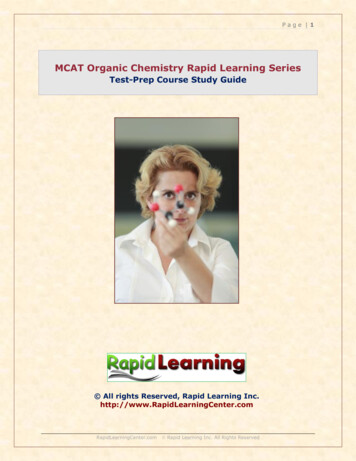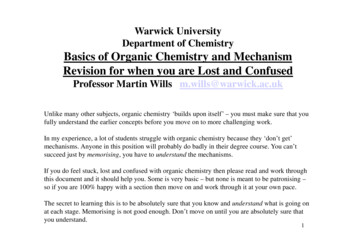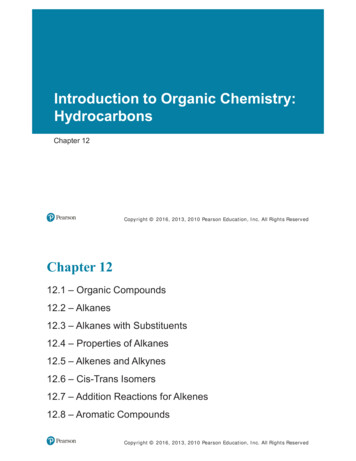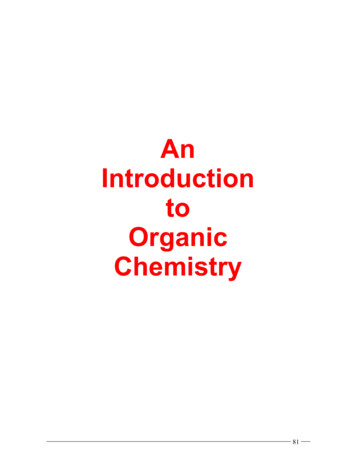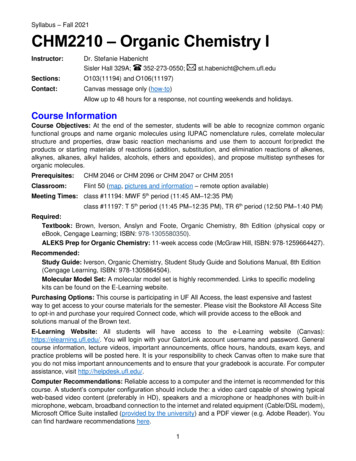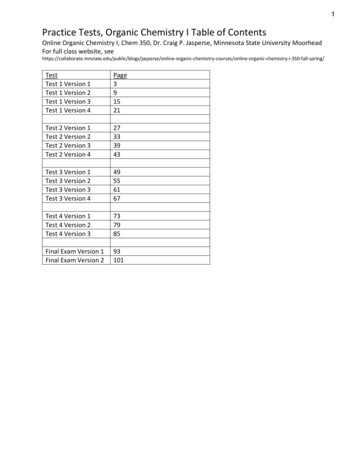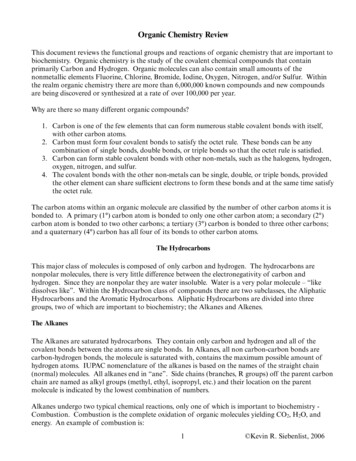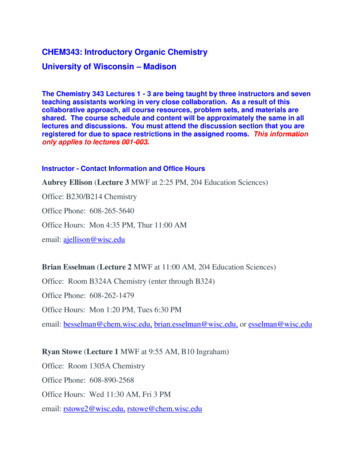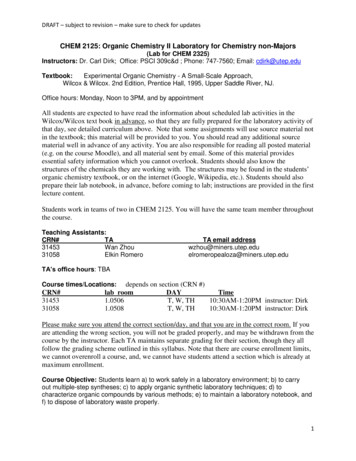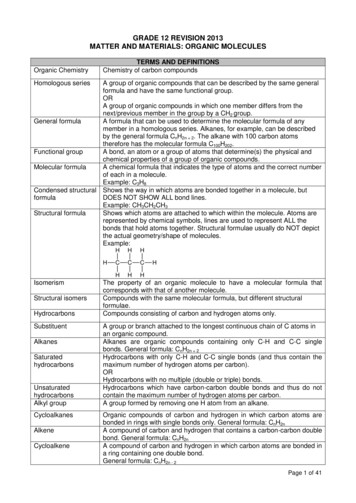
Transcription
GRADE 12 REVISION 2013MATTER AND MATERIALS: ORGANIC MOLECULESOrganic ChemistryTERMS AND DEFINITIONSChemistry of carbon compoundsHomologous seriesA group of organic compounds that can be described by the same generalformula and have the same functional group.ORA group of organic compounds in which one member differs from thenext/previous member in the group by a CH2 group.General formulaA formula that can be used to determine the molecular formula of anymember in a homologous series. Alkanes, for example, can be describedby the general formula CnH2n 2. The alkane with 100 carbon atomstherefore has the molecular formula C100H202.Functional groupA bond, an atom or a group of atoms that determine(s) the physical andchemical properties of a group of organic compounds.Molecular formulaA chemical formula that indicates the type of atoms and the correct numberof each in a molecule.Example: C3H8Condensed structural Shows the way in which atoms are bonded together in a molecule, butformulaDOES NOT SHOW ALL bond lines.Example: CH3CH2CH3Structural formulaShows which atoms are attached to which within the molecule. Atoms arerepresented by chemical symbols, lines are used to represent ALL thebonds that hold atoms together. Structural formulae usually do NOT depictthe actual geometry/shape of molecules.Example:HIsomerismStructural ocarbonsUnsaturatedhydrocarbonsAlkyl groupCycloalkanesAlkeneCycloalkeneHHHCCCHHHHThe property of an organic molecule to have a molecular formula thatcorresponds with that of another molecule.Compounds with the same molecular formula, but different structuralformulae.Compounds consisting of carbon and hydrogen atoms only.A group or branch attached to the longest continuous chain of C atoms inan organic compound.Alkanes are organic compounds containing only C-H and C-C singlebonds. General formula: CnH2n 2Hydrocarbons with only C-H and C-C single bonds (and thus contain themaximum number of hydrogen atoms per carbon).ORHydrocarbons with no multiple (double or triple) bonds.Hydrocarbons which have carbon-carbon double bonds and thus do notcontain the maximum number of hydrogen atoms per carbon.A group formed by removing one H atom from an alkane.Organic compounds of carbon and hydrogen in which carbon atoms arebonded in rings with single bonds only. General formula: CnH2nA compound of carbon and hydrogen that contains a carbon-carbon doublebond. General formula: CnH2nA compound of carbon and hydrogen in which carbon atoms are bonded ina ring containing one double bond.General formula: CnH2n - 2Page 1 of 41
Matter & Materials: Organic molecules Grade 12DieneAlkyneHaloalkane (or analkyl halide)Primary haloalkaneTERMS AND DEFINITIONSA compound of carbon and hydrogen that contains two carbon-carbondouble bonds.General formula: CnH2n - 2A compound of carbon and hydrogen that contains a carbon-carbon triplebond.General formula: CnH2n – 2An organic compound in which one or more H atoms in an alkane havebeen replaced with halogen atoms.General formula: CnH2n 1X (X F, Cℓ, Br or I)One C atom is bonded to the carbon bonded to the halogen.Example:HSecondaryhaloalkaneFSDoE Revision 2013HHCCHHBrTwo C atoms bonded to the carbon bonded to the halogen.Example:HHHCCBrHHCHHTertiary haloalkaneThree C atoms bonded to the carbon bonded to the halogen.Example:HHCHHHCCBrHHCHHAlcoholPrimary alcoholAn organic compound in which H atoms in an alkane have beensubstituted with hydroxyl groups (-OH groups).General formula: CnH2n 1OHOne C atom is bonded to the carbon bonded to hydroxyl group.Example:HSecondary alcoholHHCCHHOHTwo C atoms bonded to the carbon that is bonded to hydroxyl group.Example:HHHCCOHHHCHHPage 2 of 41
Matter & Materials: Organic molecules Grade 12Tertiary alcoholFSDoE Revision 2013TERMS AND DEFINITIONSThree C atoms bonded to carbon that is bonded to hydroxyl group.Example:HHCHHHCCOHHHCHHAldehydesCarboxyl groupOrganic compounds having the general structure RCHO where R H oralkyl. General formula: RCHO (R alkyl group)Functional group of carboxylic acids (-COOH)Carbonyl groupFunctional group of ketones ( C O)Boiling pointMelting pointViscosityVapour pressureSubstitution reactionElimination reactionAddition reactionHalogenationCrackingThe temperature at which the vapour pressure of a liquid equalsatmospheric pressure (external pressure).The temperature at which a solid changes to the liquid phase.The resistance of a fluid (liquid or gas) to flow. (The greater a fluid’sviscosity, the more slowly it flows.)The pressure at which the vapour of a substance is in dynamic equilibriumwith its liquid or solid form. (Substances with high vapour pressure arevolatile, and such substances have high volatility.)A reaction in which an atom or a group of atoms in a molecule is replacedby another atom or group of atoms.A reaction in which elements of the starting material are “lost” and a doublebond is formed.A reaction in which a double bond in the starting material is broken andelements are added to it.The reaction of a compound with a halogen (Br2, Cℓ2, I2, F2).HydrogenationThe break-up of molecules with a large molecular mass into molecules withsmaller molecular masses.The addition of hydrogen to a molecule.HydrohalogenationThe addition of a hydrogen halide (HX) to a molecule.HydrationThe addition of water to a molecule.Dehydrohalogenation The elimination reaction in which hydrogen and a halogen are lost from amolecule.DehydrationThe removal water of from a molecule.EsterificationThe preparation of an ester from the reaction of a carboxylic acid with analcohol.Page 3 of 41
Matter & Materials: Organic molecules Grade 12FSDoE Revision 2013FUNCTIONAL GROUPS OF ORGANIC COMPOUNDSHomologousseriesStructure of functionalgroupalkanesOnly C-H and C-Csingle bondsExample of a compoundNameStructural aloalkanes(alkyl halides)ethyneCCXHHbromoethane(X F, Cl, Br, I)alcohols(alkanols)COCCCHHCCHBrHHH HethanolHHCOCHH HHOHCCCHcarboxylic acidsOCethanoic acidOestersCOmethyl ethanoateCHHHOHCCHHOCCO HHHOHHOCHHNAMING OF ORGANIC COMPOUNDSThe name of every organic molecule has three parts: The parent name indicates the number of C atoms in the longest carbon chain in themolecule. The suffix indicates what functional group is present. The prefix reveals the identity, location and number of substituents attached to the carbonchain.prefixWhat and where arethe substituents?Number ofcarbon atoms1234parentHow many carbons?ParentnamemethethpropbutNumber ofcarbon atoms5678suffixWhat is the functionalgroup/homologous series?ParentnamepenthexheptoctPage 4 of 41
Matter & Materials: Organic molecules Grade 12FSDoE Revision 2013PHYSICAL PROPERTIES OF ORGANIC COMPOUNDSRelationship between vapour pressure and boiling point Compounds with HIGH BOILING POINTS have LOW VAPOUR PRESSURES.Physical properties and intermolecular forces Physical properties of compounds depend on the STRENGTH OF INTERMOLECULARFORCES (forces between molecules).STRONGER INTERMOLECULAR FORCES results in HIGHER BOILING POINTS, HIGHERMELTING POINTS, HIGHER VISCOSITIES and LOWER VAPOUR PRESSURES.TYPES OF INTERMOLECULAR FORCES Strong hydrogen bonds – only between molecules in which an H atom is covalentlybonded to a N, O or F atom.For our purposes: Only between molecules of alcohols and molecules of carboxylic acids.Examples:Alcohol molecules – one site for hydrogen bonding: HOH atom covalentlyHCbonded to O atomHHHOHydrogen bondHCHHH atom covalently bonded to O atomCarboxylic acids – two sites for hydrogen bonding:H atom covalentlybonded to O atomHydrogen bondHOHOCCOH atom covalentlybonded to O atomHHOHydrogen bond Weak Van der Waals forces – between ALL molecules. Between polar molecules(aldehydes, ketones, esters and haloalkanes) the Van der Waals forces are stronger thanbetween non-polar molecules (alkanes, alkenes, alkynes).Page 5 of 41
Matter & Materials: Organic molecules Grade 12FSDoE Revision 2013Relationship between boiling point / melting point / viscosity / vapour pressure andCHAIN LENGTHCH3CH2CH3propaneMr 44bp -42 CVan der Waals forces(only London)CH3CH2CH2CH3butaneMr 58bp -0,5 CVan der Waals forces(only London)CH3CH2CH2CH2CH3pentaneMr 72bp 36 CVan der Waals forces(only London)INCREASING CHAIN LENGTH, increasing surface area, increasing strength ofintermolecular forces, INCREASING BOILING POINT / MELTING POINT / VISCOSITY,but DECREASING VAPOUR PRESSURERelationship between boiling point /vapour pressure and BRANCHINGINCREASING BRANCHING, decreasing surface area, decreasingstrength of intermolecular forces, DECREASING BOILING POINT,but INCREASING VAPOUR PRESSURECH3H3CCCH3CH32,2-dimethylpropaneMr 72bp 10 CVan der Waals forces(only London)CH3CHCH2CH3CH32-methylbutaneMr 72bp 30 CVan der Waals forces(only London)CH3CH2CH2CH2CH3pentaneMr 72bp 36 CVan der Waals forces(only London)DECREASING BRANCHING, increasing surface area, increasing strengthof intermolecular forces, INCREASING BOILING POINT, BUTDECREASING VAPOUR PRESSURERelationship between boiling point / melting point / viscosity and TYPE OFFUNCTIONAL GROUPCH3CH2CH2CH2CH3pentaneMr 72bp 36 CVan der Waals forces(only London forces)CH3CH2CH2CHObutanalMr 72bp 76 CVan der Waals forces(London dipole-dipole)CH3CH2CH2CH2OHbutan-1-olMr 74bp 118 CVan der Waals forces(London dipole-dipole) hydrogen bondsINCREASING POLARITY OF FUNCTIONAL GROUP, increasing strengthof intermolecular forces, INCREASING BOILING POINT / MELTING POINT /VISCOSITY, but DECREASING VAPOUR PRESSUREPage 6 of 41
Matter & Materials: Organic molecules Grade 12FSDoE Revision 2013SUMMARY OF ORGANIC REACTIONS GRADE 12HHHSUBSTITUTIONCAlkane haloalkane HBr BrHC BrHBrHHConditions: heat OR sunlightReactants: alkane X2 (F, Cl, Br, I)Type of substitution: halogenation Products: haloalkane HXREACTIONS OFALKANES2C6H14 19O2 12CO2 14H2OAlkane oxygen carbon dioxide water NATIONAlkane alkene(s) alkane with shorter chainH CHHCHCl ClHCCClClHCCCHHHHC HHCH BrHHHH HCCHHConditions: unreactive solventType of addition: halogenationReactants: alkene X2 (X Cl, Br)Product: haloalkaneHHHHHHCCCH or H CCCH Br Honly productHADDITIONCHADDITIONHHType of elimination: (thermal) crackingConditions: heat high pressureReactant: alkaneProducts: alkene(s) alkane / alkene H2HHHHH H Brnot formedConditions: no water; unreactive solventType of addition: hydrohalogenationReactants: alkene HX (X I, Br, Cl)Product(s): haloalkane(s)Only product: H atom bonds to the C atomalready having the greater number of H atoms.REACTIONS OFALKENESHCH CHHHPtHCHCHConditions: Pt, Pd or Ni as catalystType of addition: hydrogenationReactants: alkene H2Product: alkaneHADDITIONHHADDITIONHHHCHCH CHHHOHHHHHHHCCCH or H CCCHOHHHOHonly productHHHnot formedConditions: excess H2O; small amount of acid(H2SO4/H3PO4) as catalystType of addition: hydrationReactants: alkene H2OProduct: alcohol(s)Only product: H atom bonds to the C atomalready having the greater number of H atoms.Page 7 of 41
Matter & Materials: Organic molecules Grade 12HHHCHCHCBrHFSDoE Revision 2013HheatH Na OHCHHHCCCHHHCHHHCCCHHHH /HCHHmajor productH NaBr H2OConditions: concentrated strong base (NaOH, KOH, LiOH) in ethanol heatType of elimination: dehydrohalogenationReactants: haloalkane concentrated strong baseProducts: alkene NaBr H2OMajor product: The one where the H atom is removed from the C atom with the least number ofH atoms (most substituted double bond forms i.e. double bond with most alkyl groups)ELIMINATIONHaloalkane alkeneREACTIONS OF HALOALKANESSUBSTITUTIONHaloalkane alcoholHHHCHCHCHBrHCHH Na OHHHCHHCHCHOHHCHH Na BrHHHHCCCCHOH HHH2SO4HHHCHHCCCHHCCCHHHHH /H H Hmajor productCHHHHCCCCHHBrHHH H2OHHHHCCCCHHOHHHHConditions: excess H2O mild heatType of substitution: hydrolysisReactants: haloalkane H2OProducts: alcohol HBrConditions: dilute strong base (NaOH/KOH/LiOH) mild heatType of substitution: hydrolysisReactants: haloalkane dilute strong baseProducts: alcohol NaBr/KBr/LiBrHHHH H2OHHCCHOH HHBrHHHCCHBrH H2OConditions: heatReactants needed: alcohol HXPrimary & secondary alcohols:NaBr H2SO4 used to make HBr in reaction flaskTertiary alcohols: water free HBr (or HCl)Products: haloalkane H2OConditions: dehydrating agent (H2SO4/H3PO4) heatType of elimination: dehydrationReactants: alcohol H2SO4Products: alkene(s) H2OMajor product: The one where the H atom is removedfrom the C atom with the least number of H atomsELIMINATIONSUBSTITUTIONAlcohol alkeneAlcohol haloalkaneREACTIONS OF ALCOHOLSESTERIFICATIONAcid catalysed condensationHHHHCCCCHHHHHHHOO HHCOCH2SO4OAlClH3HHHHHHCCCCHHHHConditions: concentrated sulphuric acid as catalyst heatReactants: alcohol carboxylic acidCOCHH H2OType: esterificationProducts: ester waterPage 8 of 41 HBr
Matter & Materials: Organic molecules Grade 12FSDoE Revision 2013TYPICAL QUESTIONSONE-WORD ANSWERS: NOMENCLATURE1.Organic compounds with the functional group OH2.The homologous series to which propan-2-one belongs3.The IUPAC name of the alkene with two carbon atoms4.The homologous series to which the compound CH3Cℓ belongs5.The general term that describes compounds that consist of hydrogen and carbon atoms only6.The homologous series to which H – C Ξ C – H belongs7.The IUPAC name of the first aldehyde in the homologous series8.Atoms, groups of atoms or bonds that give a homologous series its characteristic properties9.The IUPAC name of the first alkyne in the homologous series10. The IUPAC name of the first ketone in the homologous series11. A group of organic compounds with the carbonyl group as functional group12. The homologous series to which compounds with the functional group –OH belong13. An atom or a group of atoms that gives an organic compound its chemical properties14. Hydrocarbons containing triple bonds15. Alkanes in which a hydrogen atom has been substituted by a halogen atom16. Compounds with the same molecular formula but different structural formulaeONE-WORD ANSWERS: PHYSICAL PROPERTIES17. The resistance that a fluid offers to flow18. The temperature at which the vapour pressure of a liquid equals atmospheric pressure19. The pressure at which the vapour of a substance is in dynamic equilibrium with its liquid orsolid form20. The forces between molecules21. The type of intermolecular force formed between molecules of alkanesONE-WORD ANSWERS: ORGANIC REACTIONS22. The type of addition reaction in which a hydrogen halide reacts with an alkene23. The type of chemical reaction that takes place when an alcohol reacts with a carboxylic acid24. The reaction type that can be used to convert hydrocarbons with high molecular masses tohydrocarbons with low molecular masses25. The process in which large alkane molecules are broken up into smaller alkanes and alkenes26. The type of addition reaction in which a hydrogen halide is added to an alkene27. The type of elimination reaction during which a hydrogen halide is removed from ahaloalkane28. The type of addition reaction in which water reacts with an alkene29. Elimination of H2O from an alcohol30. The reaction of alkanes and alkenes with halogensPage 9 of 41
Matter & Materials: Organic molecules Grade 12FSDoE Revision 2013MULTIPLE CHOICE QUESTIONS: NOMENCLATURE1.Which formula shown below represents a molecule of an ester?ACH3BOHOCH3CDOCH3CCOHOCH3CH3COCH32.Which ONE of the following CANNOT be an ester or a carboxylic acid?AC3H6OBC3H4O2CCH2O2DC2H4O23.Consider the organic compound represented below.HHHCCCHHCHHHCHThe compound is .HAsaturated and branched.Bunsaturated and branched.Csaturated and straight-chained.Dunsaturated and straight-chained.4.A structural isomer of butane is methylpropane.5.The alcohols form a homologous series. This means that alcohols have .Asimilar chemical properties.Bsimilar physical properties.Cthe same molecular formula.Dthe same structural formula.6.Which ONE of the following general formulae represents alkynes?ACnH2n 2BCnH2n-2CCnH2nD7.CnH2n-1Which ONE of the following homologous series does NOT contain a CARBONYLgroup ( C O )?ABCDAldehydesAlcoholsCarboxylic acidsEstersPage 10 of 41
Matter & Materials: Organic molecules Grade 128.FSDoE Revision 2013The structures of four organic compounds are shown below.IIIC H3CH3CHCHCH3C H2CHC H3CH2OHIII CH3OHC H3CHCHOHC H3IVC H3CH3CHC H2C H3C H2OHWhich of the above compounds have the same IUPAC name?AI and II onlyBIII and IV onlyCI and III onlyDII and IV only9.Which ONE of the following compounds represents a ketone?AHHCCCHOHCOCOCOHHHHHODCOCHHConsider the compound with molecular formula C4H10. How many structural isomers doesthis compound have?A11.CHHHHHHH10.BH1B2C3D4A cyclic hydrocarbon is represented below.CH3CH2CH3The IUPAC name of the above compound thylcyclohexanePage 11 of 41
Matter & Materials: Organic molecules Grade 1212.FSDoE Revision 2013Which ONE of the following compounds has structural isomers?AHHC CCHHBHC C CC CCHHBr CCHHHBrCCDHHC C 13.HHBr HConsider the organic compounds (I to IV) shown ich of the compounds above are structural isomers?A14.C2H4I and IIICI and IVDII and IIIBC3H6CC3H8DC4H8Which ONE of the compounds represented below is an UNSATURATED hydrocarbon?AHCH16.BWhich ONE of the following compounds CANNOT be an alkene?A15.I and IIHHOCCCHHHHHCCCHHHBHHCHHDHHCCHHHHHOCCC O HHHConsider the two organic compounds represented by I and II, as shown below.HHIOHCCCHHIIOHCHHWhich ONE of the following correctly represents the homologous series to which oholalcoholaldehydeketonePage 12 of 41
Matter & Materials: Organic molecules Grade 1217.FSDoE Revision 2013The structural formula of an organic compound is given below.CH3CH3CHCHCH2CH3CCCH3The IUPAC name of this compound is e condensed structural formula of an organic compound is shown below:BrCHCH3CH2CHCH2CH2CH3CH2BrWhich ONE of the following is the correct IUPAC name of this compound?ABCD19.Which ONE of the following organic compounds is represented by the molecular OBC6H14CC7H10DC7H12Which ONE of the following compounds is an isomer of CH3CH2COOH?BOAHCCH2 CH3HCH23.BWhich ONE of the following is an alkane?A22.Ethyl ethanoateButyl ethanoateEthyl propanoatePropyl butanoateWhich ONE of the following CANNOT be an ester or a carboxylic ntaneHCCHOHCCHODHCHHOHHHHCCHOOCHHWhich ONE of the following compounds is saturated?AC4H10BC5H10CC5H9OHDC6H10Page 13 of 41
Matter & Materials: Organic molecules Grade 1224.FSDoE Revision 2013O When the group C O is present in a compound, the compound may be ABCDpropanal.1-propanol.propan-2-one.methyl ethanoate.MULTIPLE CHOICE QUESTIONS: PHYSICAL PROPERTIES25.Which ONE of the compounds shown below has the highest vapour pressure at roomtemperature?HOH H HAHCHCHCCB HHHCCODHHHHethanol26.OHHHCCFHHfluoroethaneWhich ONE of the following compounds has the highest melting point?ABCD27.CHEthanoic acidH H3Which ONE of the following compounds has the highest boiling HCH3CH3CH3CH3DCH3CCH2CH3CH3Page 14 of 41
Matter & Materials: Organic molecules Grade 12FSDoE Revision 2013MULTIPLE CHOICE QUESTIONS: ORGANIC REACTIONS28.Which ONE of the following pairs of reactants can be used to prepare the ester ethylbutanoate in the laboratory?ABCD29.Ethanal and butan-1-olEthanoic acid and butan-1-olEthanol and butanoic acidEthanal and butanoic acidThe structural formula of an ester is shown below.H H H HO HHCCCCHHHHOCHCCHHHWhich ONE of the following pairs of compounds can be used to prepare the above ester?ABCD30.Which ONE of the following reaction types can be used to prepare ethene from octane?ABCD31.Propanoic acid and butan-1-olPropanoic acid and butan-2-olButanoic acid and propan-1-olButanoic acid and onConsider the reaction represented below.HHCH CHHHHHHCCHHHThe reaction is an example of ABCD32.Which ONE of the following pairs of compounds correctly represents the products formedduring the COMPLETE combustion of itution.CO and H2OCO and H2CO2 and H2CO2 and H2OWhich ONE of the following pairs of reactants can be used to prepare the ester ethylmethanoate in the laboratory?ABCDEthane and methanoic aidMethanol and ethanoic acidEthanol and methanoic acidEthene and methanolPage 15 of 41
Matter & Materials: Organic molecules Grade 1234.The type of compound formed when but-1-ene reacts with water in the presence of a suitablecatalyst is a/an .ABCD35.FSDoE Revision 2013alcohol.alkane.haloalkane.ester.Consider the flow diagram below:H2propenecompound XPtThe IUPAC name for compound X king is an example of a/an ydrationDuring the dehydration of butan-2-ol, represented below, compound Y forms as one of theproducts.HHHHdehydrationHCCHHHCCOHYHWhich ONE of the following is the correct condensed structural formula for compound Y?AC H2C H3CC H3BCHC H2C H2C H3C H3C H3OHDC H3CHC H2CHC H2C H338.C H2OHA simple reaction scheme is shown below.CH3CH CH2HBr(g)Xreflux withY HBrNaOH(aq)The formula for Y is ge 16 of 41
Matter & Materials: Organic molecules Grade 12FSDoE Revision 2013STRUCTURED QUESTIONS: NOMENCLATUREQUESTION 1Consider the organic compounds labelled A – HCCCCHHCHHHCHHHHTo which homologous series does compound C belong?Compound C reacts with chlorine gas in an inert solvent. Using structural formulae, write abalanced equation for the reaction that takes place.Write down the IUPAC name for compound B.Write down the structural formula of an isomer of compound A that has only FOUR carbonatoms in the longest chain.QUESTION 2The letters A to F in the table below represent six organic compounds.ACHCH2CH2CCH3BCH3CH2CH2CHCH3 OHDPentanoic acidCH3CCH2CCH2CH3EHHHHOCCCCH HCH 2.2.12.2.22.32.3.12.3.22.3.3Write down the letter(s) that represent(s) each of the following:An alkyneTwo compounds that are structural isomersA compound containing a carboxyl groupAn aldehydeAn alcoholWrite down the:IUPAC name of compound CStructural formula of compound DCompound F is prepared in the laboratory.How can one quickly establish whether compound F is indeed being formed?Write down the IUPAC name of the alcohol needed to prepare compound F.Write down the IUPAC name of compound F.Page 17 of 41
Matter & Materials: Organic molecules Grade 12FSDoE Revision 2013QUESTION 3The letters A to F in the table below represent six organic compounds.AHBHHHHOCCCCCHHHHCHHHCCCHHHHCDCH2C 4.4HHC H2HFHHHHCCCCHHHHHethyl butanoateWrite down the letter that represents the following:A ketone3.1.2 A compound which is an isomer of prop-1-eneWrite down the IUPAC name of the following:Compound A3.2.2 Compound BWrite down the NAME or FORMULA of EACH of the TWO products formed during thecomplete combustion of compound E.Compound F is the organic product of the reaction between a carboxylic acid and ethanol.Write down the following:The name of the homologous series to which compound F belongsThe structural formula of the FUNCTIONAL GROUP of carboxylic acidsThe IUPAC name of the carboxylic acid from which compound F is preparedThe structural formula of compound FQUESTION 4Four compounds, labelled A, B, C and D, are shown Hhexanoic acidHWrite down the:4.1Homologous series to which compound A belongsPage 18 of 41
Matter & Materials: Organic molecules Grade 124.24.34.44.5FSDoE Revision 2013IUPAC name of compound AIUPAC name of compound BIUPAC name of compound CStructural formula of compound DQUESTION 5The chemical properties of organic compounds are determined by their functional groups. Theletters A to F in the table below represent six organic nalHHHHHHDCCCCBrHHHOCCHHCCHHHHHFOMethyl te down the LETTER that represents the following:An alkeneAn aldehydeWrite down the IUPAC name of the following:Compound BCompound CWrite down the structural formula of compound D.Write down the IUPAC name of the carboxylic acid shown in the table.Write down the structural formula of compound F.QUESTION 6The letters A to F in the table below represent six organic compounds.HABPent-2-eneHHHCCCCHHHHOHHCDPropyl methanoate2,5-dimethylheptaneOECH3CHC H3CH2CHFCH3CH2CH2CCH3OPage 19 of 41
Matter & Materials: Organic molecules Grade 36.3.16.3.2FSDoE Revision 2013Write down the letter representing the compound which:Is an aldehydeHas the general formula CnH2nIs unsaturatedIs a ketoneIs a hydrocarbonCan be prepared by the reaction of an alcohol with a carboxylic acidWrite down the structural formula of:Compound ACompound DWrite down the:NAME of the functional group of compound FIUPAC name of compound BQUESTION 7Millions of organic compounds are known to date. Four of these compounds, represented by theletters P, Q, R and S, are shown in the table CℓH7.17.1.17.1.27.1.37.1.47.2Write down the following:Structural formula of the functional group of PHomologous series to which Q belongsStructural formula of an isomer of QIUPAC name of RS represents an alcohol. Classify this alcohol as primary, secondary or tertiary.QUESTION 8Consider the following terms/compounds in organic drohalogenationpotassium hydroxidealkynesChoose from the above terms/compounds: (Write down the question number only and next toeach the correct term/compound.)8.1The homologous series that has a carbonyl group as functional group8.2A saturated hydrocarbon8.3The product formed when an alkane reacts with a halogenPage 20 of 41
Matter & Materials: Organic molecules Grade 128.48.58.68.78.88.9FSDoE Revision 2013The homologous series to which propanal belongsThe homologous series to which 2-bromobutane belongsThe reaction of 2-bromobutane with waterAn unsaturated compound that has isomersA compound which belongs to the homologous series with the general formula CnH2n - 2The type of organic reaction during which hydrogen chloride reacts with etheneQUESTION 9Rubber is a naturally occurring compound.repeating units found in rubber.The diene, 2-methyl-1,3-butadiene, is one of theOver 20 million families depend on rubber cultivation for their livelihood. Tens of thousands ofhectares of tropical forests have been cleared to make way for rubber plantations.Chemists have been able to combine other dienes to obtain synthetic rubbers. Some rubberproducts include latex products such as hand gloves, raincoats and other products used in thebattle against HIV/Aids.The world's largest use of rubber is in tyres, and most tyres contain both natural rubber, whichwithstands heat better, and one or more kinds of synthetic rubber.9.1Is 2-methyl-1,3-butadiene an example of a saturated or an unsaturated hydrocarbon?Give a reason for your answer.Write down the structural formula of 2-methyl-1,3-butadiene.With regard to the environment, name TWO disadvantages of rubber and the production ofrubber.With regard to human life, name TWO benefits of rubber and the production of rubber.9.29.39.4QUESTION 10The letters A to F in the table below represent six organic HHHHOCCHOHHCHHHHHCCCCCCHHHHHHCHHEthyl methanoateHH10.1 Write down the LETTER(S) that represent(s):10.1.1 Two hydrocarbons10.1.2 A carboxylic acidPage 21 of 41
Matter & Materials: Organic molecules Grade 12FSDoE Revision 201310.2 Write down the IUPAC name of:10.2.1 Compound B10.2.2 Compound E10.3 The IUPAC name of compound F is given in the above table.Write down the:10.3.1 Structural formula of compound F10.3.2 Homologous series to which compound F belongs10.3.3 IUPAC name of an alcohol that can be used to prepare compound F10.4 Write down the:10.4.1 Homologous series to which compound C belongs10.4.2 Structural formula of a ketone that is a structural isomer of compound CQUESTION 11Consider the organic compounds represented by the letters A to F in the table below.BHCHHCCHHOOHHCCCHHHHpropanoic 11.3.111.411.511.611.7Write down the IUPAC name of:Compound A11.1.2 Compound E11.1.3 Compound FWrite down the structural formula of:Compound C11.2.2 Compound DWrite down the name of the homologous series to which each of the following belongs:Compound B11.3.2 Compound AWrite down the name of the functional group of compound B.Write down the letters (A to F) that represent TWO compounds in the above table thatare hydrocarbons. Give a reason for the answer.Write down the letter (A to F) that represents an UNSATURATED compound in theabove table. Give a reason for the answer.Write down the general formula of the homologous series to which compound Cbelongs.Page 22 of 41
Matter & Materials: Organic molecules Grade 12FSDoE Revision 2013QUESTION 12The letters A to J
an organic compound. Alkanes Alkanes are organic compounds containing only C-H and C-C single bonds. General formula: C n H 2n 2 Saturated hydrocarbons Hydrocarbons with only C-H and C-C single bonds (and thus contain the maximum number of hydrogen atoms per carbon). OR Hydrocarbons with no multiple (double or triple) bonds. Unsaturated

